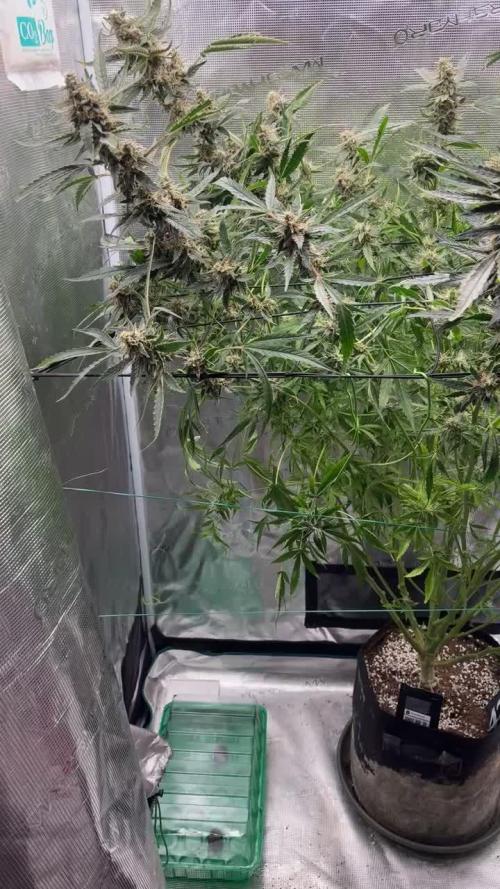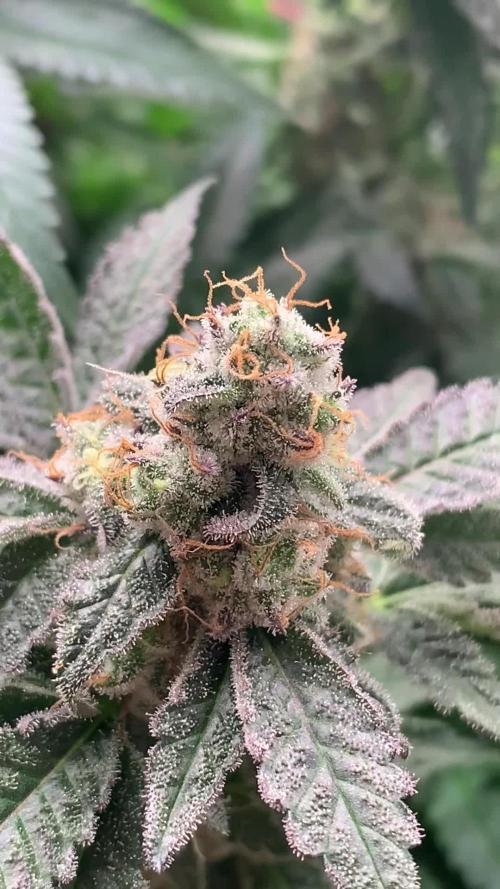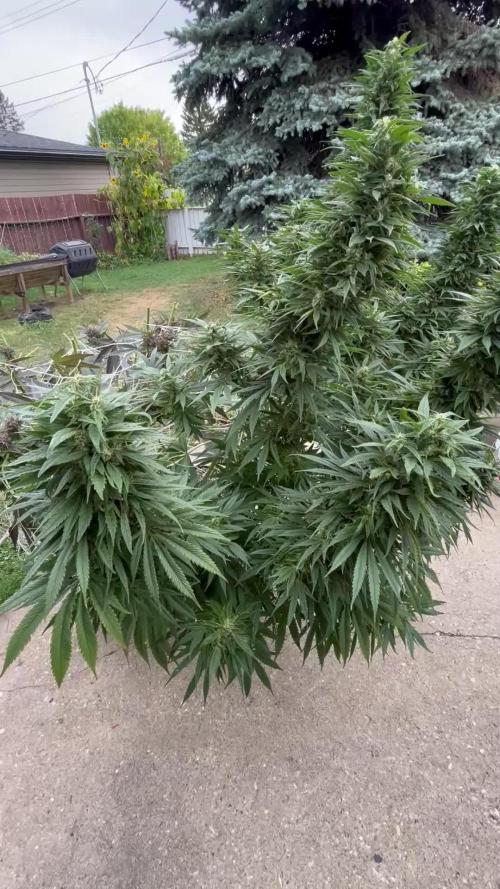The Grow Awards 2026 🏆 


























Likes
45
Share

This ones. Coming along. Nice still. Buds. Starting. To thicken and. Form color is nice. Still. White still healthy. I did cut off the grow. And upped the. Bloom and micro. Last week noticed a claw. But manky from fan. Some n too 80% is fine so not gonna stress it. No burn or nothing and been holding. For 2 weeks. Now so just gonna. Let her so her thing. Happy growing guys.F38. Getting some size to um now. Smells coming. In and. Smells. Like fruit and. Shit. Lol. Happy growing guys
Likes
28
Share


@cheetah844
Follow
They are still growing nicely, continuing to bush out since LST. A healthy green & what will be a bunch of future bud sites keep showing up daily.
Likes
15
Share


@Ronzo9
Follow
Still struggling with humidity but the plant seems to be doing ok! It’s gotten lots more bushy and is starting to grow up the way a bit more which is promising. I dropped the root juice as of yesterday and trimmed down the nutrient dosage as I looked at the bio bizz feeding schedule for my soil (which is all in one) and I was slightly over doing it with the nutes.
I’ve raised the lamp up on the bucket as I was afraid of lamp burn on the leaves and this has dropped the temperature inside the bucket to about 22 degrees.
I’m always open for feedback since this is my first grow.
Thanks guys
Likes
12
Share


@SkunkyDog420
Follow
Hallo zusammen 🤙.
Sie wächst sehr schön und macht keine Probleme.
Rabattcode für den BIOTABS-Webshop https://biotabs.nl/en/shop/ GDBT420, damit erhalten Sie 15 Prozent
Likes
8
Share


@NoProbation4Weed
Follow
i harvested second part this week. the rest will be harvested in about a week. Buds turned out beautifully. Great Colours and great smell.
My best Autoflower so far. Terps are dark and red Berrys combined with some floral Rose aroma. Super Sticky and as you can see good producer.
Likes
56
Share


@JuanHaze_Arg
Follow
18/05 se riega con 2,5L de agua (60% de agua de osmosis inversa + 40% de grifo) + 1ml de calmag de top crop, + 0,5gramos de trico+ de namaste nutrientes. PH 6.4 EC: 1.0
21/05 se riega con 3 L de agua de osmosis inversa + 1ml x L de cal mag + 3 ml de zym (treemix pro enzimas) PH: 6.4 EC: NO MEDÍ ya que es para empezar a lavar raíces
Likes
11
Share


@CannaChris_grows
Follow
This cultivar was an absolute dream to grow it was so easy so beautiful smelt so good. It was definitely the star of the show on this run
Likes
70
Share


@Insaniac_0
Follow
All feeds with nutes use either a whole ratio or combination of "Veg Mix" and "Bloom Mix"concentrates DILUTED in water until a total ppm of add in is reached using a (Total Dissolved Solids)TDS Meter measured in PPM (parts per million). The "Veg Mix" concentrate will eventually be added in smaller ratios and "Bloom Mix" concentrate what will eventually replace the "Veg Mix" concentrate entirely with the ppm and ratios listed when I feed. Veg mix recipe is on week 3. Bloom Mix recipe is on week 5.
Day 70/0
Flipped to 12/12 - increased ppfd by 100 and worked to stabilize temps/humidity with new gear. I used 15 minutes of IR light before main lights and then 30 minutes of UV light at mid day and will still use 15 minutes of IR light after main light are out. I plan to increase the time of UV lights to a max of 2.5 hours per day mid day but for now Im easing her into the treatments.
Watered with 1.12 gallons of 6.3ph de-chlorinated tap water, used 50ppm of veg mix and 50ppm of bloom mix in the water. VPD is mostly steady 74F/65%RH/33%ILV
Day 71/1
tested and calibrated my meter, tested the top soil 1 day after feed for ph - tested 4 times for an avg of 6.48
Trimmed brown leaves and did some HST/LST training/binding. Took control pics for UV treatments of 15 minutes per day. Will monitor and increase weekly it she holds up okay. Still doin 15 minutes of IR light before and after lights on/off.
PPFD after training was 630 at highest and 540 lowest. VPD was 74F/60%RH/33%ILV
Day 72/2
Just a watch today, VPD was 75F/60%RH/setting 4/10 of ILV (about 33% like the last tent)
PPFD ranged from 530 to 650. I only used 5 minutes of UV light today as she has a tinge of browning on the tips of a few leaves. Im not cutting it out completely because I still plan to use upto 2.5 hrs by end of flower, so she needs to adjust. Im also still using 15 minutes of IR before and after main light schedule.
Her stretch seems to be picking up, from 16 inches 2 days ago to 18 today.
Day 73/3
VPD same as yesterday 75F/60%RH/40%ILV
PPFD hit 670 at highest and 550 at lowest. Stayed with 5 minutes of UV light and monitored burnt tips from previous days... no spread, so I may add 5 more minutes tomorrow and monitor. 15 minutes of IR before/after main light schedule.
Growth continues, another inch in stretch to 19 inches. I turned her slightly because there are still two runted colas that I rather provide more light to. It's been 3 days since last feed and I think with as much growth as she's putting on, I should feed again tomorrow. Im still introducing nutes in lower portions but will add 300ppm and feed about 2 gallons at a 25/75 ratio of veg:bloom mix to see if I can get some run off to measure conditions.
Day 74/4
Watered with 2 gallons of 6.4 ph de-chlorinated tap water. I added 300ppm total of 25% Veg/75% Bloom. Starting ppm was 296; ending was 595 and I added a pinch of epsom salt. Poured over the whole base until I got runoff - Since I was so close to the whole 2 gallons, I used it all. I only used the feed water over the roots today as I want her to get the nutes from the soil since the transfer into new soil was so recent.
So far VPD is 75F/60%RH/40%ILV. No issues with controls.
PPFD was upto 700 at center so I raised the lights to almost 42" from soil - Since the plant is almost 20" that's 22" leaves to light. New PPFD now ranges at 480 to 650 on 70% power.
I increased UV time to 10minutes today and took control pics for light burn. I am still using 15 IR before and after main lights.
Took some black back picks since I think she's looking good now.
Day 75/5
Started the day with evaluation of ph and control pics. Comparisons show no further spread of lock out issues from earlier or light burn of a more recent change. Upto 20 inches before HST/LST today.
Meter was tested/calibrated and soil ph was tested 4 times for avg of 6.34 (yesterday's runoff was about 6.35 too) Soil temp is about 66F. Also tested CO2 and got 1050. Room VPD was 74F/60%RH/30%ILV
I spread the leaves further apart because I noticed there were two colas not getting as much light and somewhat crowded by the colas near by. So I positioned the larger part of the tomato ring around the limbs extending here out to 32x32 and the used HST/LST to break and bend the center colas inward clockwise (I think I went a bit too hard on one as the others already show a bounce back and now one is still limp-ish (will monitor obviously) But with that the height is now 18" so 32x32x18 - but here's the kicker, I only have a 24x48 tent, so there's a few colas touching the walls and doorway now, so I may have to reconsider the larger ring.
New position, new PPFD right?, not exactly, for some reason these settings still gave me range of 480 to 650 as I had yesterday with just a few more of the outer colas have 480 than yesterday. However, there's more light getting lower levels now and I only had to cut 1 leaf. Which is good because I did 15 minutes of UV today with the regular 15 minutes of IR before and after main lights.
Day 76/6
VPD is a lil wonky now as humidity is starting to go up in the tent - so I plan to put in the dehumidifier this weekend and just leaving the humidifier off today and tomorrow. Heat seems to also be ticking up - so I reduced the temp on the heater and will monitor. Temps about 75 to 76 - humidity at about 62% as high as 65 though and Im trying to be at or under 60 this week. Increased ILV to 40%
I repositioned the fans to hang on the lights while blowing down onto the plant. I tried to make every leaf dance a little.
LST seemed to hold up okay - had to reposition a few branches and thinking I may have to build a larger box this weekend since the colas are now pressing the door and back wall.
PPFD is between 470 and 700. I used 15 minutes of UV mid day with 15 minutes (30 total) IR before and after main light timers.
Likes
18
Share


@Ananas_Comosus
Follow
Monday, 14.03.2022
All plants seem to be almost fully recovered from phytotoxicity a few weeks back. They are stretching nicely and putting out new leaves. Numerous bud sites developing. I would have wanted them to be bulkier but let's see how they do. No significant rain this past week so I was able to feed a couple times. 8~ml per 5 gallon tap water Ph Down got me to around 6 Ph. I thought I would have needed to water on Thursday since two days had passed since I last watered but the plants seemed turgid and OK and Friday night was the same so I didn't water until Saturday. Found a mature stink bug hiding under a leaf on a stem top.
Likes
28
Share


@BB_UK
Follow
Started the flush for these 2 now! They’re frosting over with so much trichromes and smells quite like citrus haze and sherbet on Aroma! Very interested to see how these buds fatten up! Stay tuned. Hopefully get some decent fades
Likes
16
Share


@Mrs_Larimar
Follow
2022-10-31
Both Plants doing fine,
Its hard to show how the plant in the glasskull grows, because ihave covered the
bottle, to keep the Roots happy
the purple cup moved into 12/12
the glasskull remains in vegetation
They are fed daily with a weak solution (900PPM)
solution is stuffed with beneficals too, so the Girls stay happy
website for for my Fertilisers:
https://greenbuzzliquids.com/en/shop/
Code: mrs_larimar
Breeder Info:
👉Black Sugar is an indica dominant hybrid of Black Domina, L. A. OG and Critical.
It has kept the medicinal properties of L. A OG, a good flowering rate on the Black Domina lineage,
and the compact size of the classic Critical strain. With its small growth, the strain produces large yields
of up to 600gr/m2 on bushy branches. The buds are very dense and stinky.
Black Sugar has a high THC level. The variety has a fruity citrus aroma. Dense smoke gives the effect of relaxation and body buzz.
Good for Smoking before going to bed. It can become one of your favorite Seedsman strain
Genetics Black Domina x L.A OG x Critical
Harvest 450 - 500 g/m²
Flowering 50 - 55 days
THC 20.0%
CBD 1.0%
Likes
21
Share


@Mousse
Follow
Lampe 100%
So langsam nähert es sich dem Ende zu, sehr schade, da mich die Sorte mit der combo coco doch recht überreicht hat🔥🔥🏽
Anfang dieser Woche habe ich #1 und #3 Geerntet, dann zum Ende dieser Anfang nächster Woche kam dann auch die #2 raus. 🍀
Mo : Fotos
Di:
Gießen: #1/3
4L-6L je
-nur wasser mit pH5.8
-wurde bereits Teil geerntet
Gießen: #2
4L-6L je
Dünger für Mitte:
Canna Coco A&B = 1 ml/L
CalMag = 0,6 ml/L
Cannazym = 0,5 ml/L
Sugar Royal = 0 ml/L
Green Sensation = 0 ml/L
pH: 5.8
EC: 1,2
Mi:
- #1 und #3 geerntet
- Vorbereitung auf flussh
- Fotos
Do:
Gießen: #2
6L-8L je
Dünger für Mitte:
Canna Coco A&B = 0,5 ml/L
CalMag = 0,4 ml/L
Cannazym = 0,3 ml/L
Sugar Royal = 0 ml/L
Green Sensation = 0 ml/L
pH: 5.8
EC: 0,8
Fr:
Sa:
Gießen: #2
6L-8L je
Dünger für Mitte:
Canna Coco A&B = 0,5 ml/L
CalMag = 0 ml/L
Cannazym = 0 ml/L
Sugar Royal = 0 ml/L
Green Sensation = 0 ml/L
pH: 5.8
EC: 0,7
So:
Mo:
Gießen: #2
6L-8L je
Dünger für Mitte:
Canna Coco A&B = 0 ml/L
CalMag = 0 ml/L
Cannazym = 0 ml/L
Sugar Royal = 0 ml/L
Green Sensation = 0 ml/L
pH: 5.8
EC: 0,8
Di:
- #2 geerntet
—————————————————
Sooooo
Alles hat ein Ende.. und dieser war nicht heute!!!
Werde den Grow nochmal machen, aber mit Training pur.🔥🔥🔥
Likes
28
Share


@MadeInGermany
Follow
Hey everyone 😃.
This week she has done great 👍.
It was done again on all the drifted topping and sprayed one last time with neem oil so that the last trips are finally gone 😁.
We haven't had any pests for so many years and all of a sudden we have such little shit parts 😅.
This week it was poured twice with 1.2 l of water.
GHSC enhancer was added during a pouring (1 g per l)
The tent was cleaned every day this week and the plants were checked for health.
The humidifier is filled once a day.
Next week I will decide how I will continue the training because I have space again in the flower tent 😀.
This week I'll decide whether it goes straight into the flower tent or is pruned again.
Until then, I wish you and your families a good start into the new year 2021 🙏🏻.
Stay healthy and let it grow 🍀
You can buy this Strain at :
https://www.royalqueenseeds.de/feminisierte-hanfsamen/115-amnesia-haze.html
Type:
Amnesia Haze
☝️🏼
Genetics:
Original Amnesia Haze
👍
Vega lamp:
2 x Todogrow Led
Quantum Board 100 W
💡
Bloom Lamp :
2 x Todogrow Led
Cxb 3590 COB 3500 K 205W
💡💡☝️🏼
Soil :
Canna Coco Professional +
☝️🏼
Fertilizer:
Green House Powder Feeding
☝️🏼🌱
Water:
Osmosis water mixed with normal water (24 hours stale that the chlorine evaporates) to 0.2 EC. Add Cal / Mag to 0.4 Ec Ph with Organic Ph - to 5.5 - 5.8 .
Likes
14
Share


@Dunk_Junk
Follow
I have no idea why I didn't take photos this week.... 😶
Possible stoner moment... not gonna lie.. 😂
She's getting closer to the end though.


























